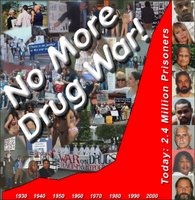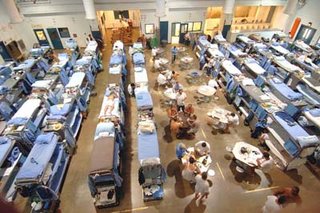
This morning I read an email from
Fed-CURE's elist. Kenny Linn posted the transcript of a hearing held in July, 2008—an appropriations hearing on the fiscal year 2009 Federal Prison budget request, shortages in the budget for 2008 and other matters. After reading the transcript, it was as Kenny Linn, promised -- a great read. We've
posted the transcript here, and will provide a link to the government website that hosts this public information is found.
We need a system of earned, early release -- called parole, and/or increase of good time -- and won't have one until a citizen force has support of leaders in Congress. That was on my mind as I read the transcript linked above. I hope it will be on your mind, and you'll download and send it to your imprisoned loved one, or
donate to our organization because people in prison with no one left on the outside, ask us to send them copies of important documents. The documents find their way to law libraries. Other prisoners direct their family members to the information online, and public education increases, along with pressure on leaders that can change sentencing law. Without your support, we can't serve as liaison between the public, our leaders and the millions of people that have found themselves incarcerated under our nation's dubious 'drug laws.' Now, back to this interesting hearing...
During questioning about whether or not prisoners receiving sentencing reductions due to the crack cocaine law changes were getting drug treatment before release, Representative Mollohan said, "And I am totally in favor of more sympathetic treatment to people who are in jail because of drug use offenses." Progress, yes, but when will republican and democrats alike ask why the federal government is in the business of jailing drug use offenders? Alan Mollohan is a democrat, represents West Virginia and has been in Congress since 1983.
Republican Representative Hal Rogers, hails from Kentucky's 5th district and a member of the House Appropriations Committee since 1982, and chairman of the Subcommittee on Commerce, Justice, State and the Judiciary since 1995. In short, another key person when it comes to funding US punishment policy.
Overcrowded Prisons
Mr. Rogers. Thank you, Mr. Chairman. Mr. Director, welcome to you and to all your staff. I have been told that you are 37 percent overcrowded. Is that an accurate figure?
Mr. Lappin. We are 37 percent over rated capacity.
Mr. Rogers. Over what?
Mr. Lappin. Over rated capacity.
Mr. Rogers. Do you mind if I call that overcrowded?
Mr. Lappin. Okay.
Mr. Rogers. What would be your target?
Mr. Lappin. 15 to 17 percent. That is our target.
Mr. Rogers. Over your rated capacity?
Mr. Lappin. And so, let me kind of put it in perspective.
What does that mean? What does 17 percent mean over rated capacity? That means that every cell in the entire Bureau of Prisons has two inmates in it, and we believe in that goal. It may be a long term goal, there is no way we are going to get there overnight, but our goal would be that we get to the point where cells that were built of a certain size, which is a standard size--you have got a couple new prisons in Kentucky, they are a standard size--for a cell of that size it is appropriate for two inmates to be housed in those cells long term. At 17 percent, every cell in the Bureau of Prisons would have two inmates in those cells.
Now realize there are some inmates that cannot be housed with anyone. So for those that require single cells, it is going to push into other cells three inmates. We are okay with that. There are certain inmates that we could temporarily house in that manner. Our target is 17 percent. Mr. Rogers. Well, if you are 37 percent over now and you want to be at 17 percent, that is a 20 percent difference.
Two person, three person cells? I wondered if Mr. Rogers and Mollohan and Frelinghuysen knew about the 'dorms'. Do our leaders know that thousands of federal prisoners are being warehoused like this?
I ask the question because Rep. Frelinghuysen asked Director Lappin if people released under changes in crack-cocaine sentencing were going to be monitored. Lappin explained supervised release. Why didn't Director Lappin just hold one of these big blow-up pictures of the dorms in federal prisons? In the camps, dorms like these are the norm. What if Congressional funders knew what a human warehouse looked like?
Harley Lappin warns that federal prisoners will likely have to be housed further from home, and that they expect growth of 5,000 to 7,000 federal prisoners each year over the next several years. In 1997 the ratio of guard to prisoner was 3.57, today mostly due to budget shortages and difficulties hiring, the ratio is 4.92 inmates to 'every employee.' The states have a 3.33 ratio.
The litany of horrors of this testimony is nothing new, but the federal bureau of prisons appears to have reached a new crisis and due to funding shortages there will be slow activation of a new federal prison in Louisiana -- FCI Pollock.
Race, age and offenses
Mr. Lappin. Let me give you an idea. About 56 percent of the federal inmate population is white, 40 percent is black, 1.7 percent Asian, 1.8 percent Indian. Of that it is 31 percent Hispanic, so a combination of some folks who are African American, black, Hispanic. Age has really not fluctuated much.
You know, we are around a thirty-five average age.
Mr. Frelinghuysen. Thirty-five years of age?
Mr. Lappin. I think that is what it is. It is pretty close to that. What has changed, though, the characteristics that have changed are--let me back up to types of offenses. We continue to see the majority of the offenders coming in for drug related offenses. About 52 percent to 53 percent of the offenses are drug related. And then followed by weapons at about 14 percent.
Mr. Frelinghuysen. That drug related figure is a pretty----
Mr. Lappin. I am sorry?
Mr. Frelinghuysen. That drug related is a pretty----
Mr. Lappin. 53.9 percent drug related.
Mr. Frelinghuysen. And that is, let us say ten years ago that might have been considerably lower, or?
Mr. Lappin. Well, that was probably in the middle of the whole War on Drugs. That is when we were ramping up, getting a lot of folks. But you know, if you go back fifteen years, it is much larger. We have seen a significant increase in weapons. Offenders coming into us with weapons violations, that is up to 14 percent followed by immigration.
I would like to have know what Representative Frelinghuysen, was going to say beyond, "That drug related figure is a pretty----." Lappin cut him off, twice in fact. Republican Rodney P. Frelinghuysen is serving in his
seventh term as the Representative for New Jersey's 11th Congressional District and a
senior member of the House Appropriations Committee.
Members of Congress want to explore and discuss, drug policy, federal policing and sentencing. It's clear to me. They get cut-off, and the witnesses confuse them, aren't talking straight and honest about problems that are very massive, expensive and can result in more, not less social destruction.
Other key subjects of the hearing included under staffing, the prison chaplain library 'project', recidivism, Stun or Lethal Fences, the crack sentencing amendment, counterterrorism work in federal prisons, drug treatment programs, inmate medical care, federalized sex crime, programs to reduce recidivism, health care costs, gangs and terrorism, contraband and staff searches, terrorists, non-US Citizen Inmates with an eye to the possible early release for purposes of deportation, Tele-Health, and Reimbursable agreement with BICE (a private corporation that owns prisons that hold non-citizens called long-term 'detainees' not inmates).
Advocates for federal prisoners, detainees and journalists covering over-reliance on incarceration, mandatory minimum sentencing, and recent US Sentencing controversies will find the transcript of this hearing important reading.
Labels: Federal Guideline Sentencing, mandatory minimum sentencing




